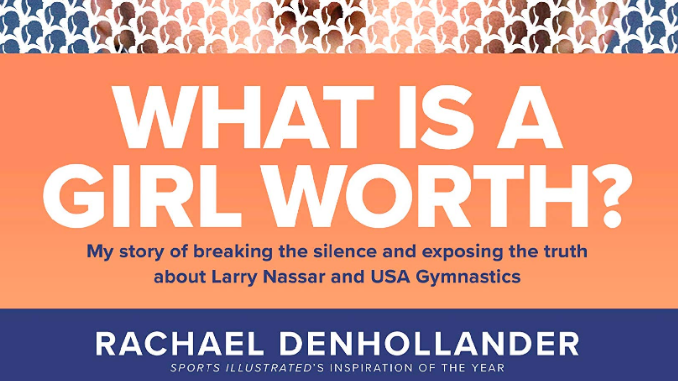
Also by this author: How Much Is a Little Girl Worth?, How Much Is a Little Boy Worth?
Published by Tyndale on September 10, 2019
Genres: Non-Fiction, Sports, Memoir
Buy on Amazon
Goodreads

"Who is going to tell these little girls that what was done to them matters? That they are seen and valued, that they are not alone and they are not unprotected?"
Rachael Denhollander's voice was heard around the world when she spoke out to end the most shocking scandal in US gymnastics history. The first victim to publicly accuse Larry Nassar, the former USA Gymnastics team doctor who abused hundreds of young athletes, Rachael now reveals her full story for the first time. How did Nassar get away with it for so long? How did Rachael and the other survivors finally stop him and bring him to justice? And how can we protect the vulnerable in our own families, churches, and communities?
What Is a Girl Worth? is the inspiring true story of Rachael's journey from an idealistic young gymnast to a strong and determined woman who found the courage to raise her voice against evil, even when she thought the world might not listen. This deeply personal and compelling narrative shines a spotlight on the physical and emotional impact of abuse, why so many survivors are reluctant to speak out, what it means to be believed, the extraordinary power of faith and forgiveness, and how we can learn to do what's right in the moments that matter most.
This is not a book anyone should have to read. This decades-long memoir of sexual abuse by a man in power and the justification, equivocations, and cover-ups that only just barely ends with justice (though, in truth it’s still on-going today) is not a fun, pleasant, or enjoyable read. With clarity and precision, Rachael Denhollander outlines her abuse at the hands of a prominent Team USA physician and the lengthy legal battle that followed.
This is a book everyone must read. And for exactly those same reasons. There is no valid reason for this book to have been written. The red flags were all over the place. Larry Nasser’s sexual abuse of young children should have been stopped long before we get to even chapter three. The fact that it didn’t. The fact that it would be decades before he was stopped. That the institutions rose up to muzzle the victims and defend their inaction. That USA Gymnastics continues to silence victims and deny them a voice. That they continue to fight financial restitution for those they harmed. For all that, What is A Girl Worth? must be read.
The events of this book should never have happened. Don’t let the fact that it ends with Nasser serving life in prison negate that fact. What is A Girl Worth? is not a success story about how we got the guy. It’s a story of systemic failure so great that it took the often-voiceless victims rising up en masse—with Denhollander at the helm—to gain this small piece of justice.
All the accolades that Denhollander has received—one of Time’s 100 Most Influential People, one of Glamour magazine’s Women of the Year, a co-recipient of ESPN’s Arthur Ashe Courage Award—I’m sure she would trade them all away if it meant that Larry Nassar never harmed a little girl. But things being as they are, it is so relieving to see the world finally standing up and taking notice of the victims of sexual assault. For speaking out, Denhollander deserves all these things. I can’t imagine what it would have been like to write this book. I suppose when the memories are fresh from the repeated legal testimonies, writing them down one more time doesn’t seem as traumatic.
What is A Girl Worth? begins with young Rachael Denhollander’s introduction to gymnastics: it’s highs and lows, it’s struggles and successes. Rachael was an average competitive gymnast, if that. She wasn’t going to be an Olympian. Gymnastics was fun and she loved to compete, but it wasn’t going to be a way of life. Nonetheless, after dealing with some chronic injuries, she was referred to a doctor who treated the best of the best. University of Michigan and Team USA doctor Larry Nassar.
Denhollander does not shy away from portraying Nassar as he is: friendly, caring, personable. It was these qualities and allowed him to get away with his abuse for so long. He comes across as genuinely likable—something not always seen in sports medicine. When Denhollander describes his molestation, done under the guise of a medical procedure, you really understand the feelings of her teenage self. Did he just do that? Was that wrong? I guess it’s ok because he’s a doctor.
And that’s the way a lot of sexual predators behave. They normalize and rationalize the abuse, not just to themselves but also to their victims. Her mom was sitting right there! But of course she didn’t realize until later that Nassar had moved so as to block her mom’s view.
When the abuse became apparent to Denhollander and her mother, they stopped seeing Nassar but never filed a police report or made any other claims. Why? Because maybe it had been an accident. Maybe he did have a medical purpose. And he was in a position of power—not just over his patients but over their families as well. He was a doctor for the Olympic team!
Life moved on. Somewhat. Denhollander describes the long-lasting effects Nassar’s abuse had on her leading up to when she was almost unexpectedly thrown back into the world of gymnastics. She learned that that Indy Star was investigating sexual abuse allegations within USA Gymnastics. It was then she knew she had to tell her story.
The second half of the memoir details the journey from being interviewed by the Star, wondering if their piece would ever air, to actually formally filing a police report against Nassar. Between the two, and with more victims coming to light—some speaking out anonymously, some willing to talk publicly—Nassar was stripped of his medical license and eventually brought to trial.
Denhollander talks about the tension of this time, how the powers surrounding Nassar turned rapidly against her and others speaking out. Even as things should have been getting easier, even as proof of Nassar’s crimes were becoming self-evident, it wasn’t a guarantee that he would actually face any consequences for his actions. Frankly, it’s disheartening and disgusting.
But eventually, Nassar was convicted and sentenced. That long part of the saga was over, and a new beginning was coming. Let me close with these lines from the book:
A couple of months before the awards presentation, Glamour invited a group of the survivors to gather for a group photo in Michigan’s Supreme Court building, which is fittingly called the Hall of Justice. I held my three-year-old, Ellianna, in my arms as the photographers began lining us up for the photo…
‘Who are they, Mommy.’
‘They are Mommy’s friends, sweetheart, the one who put a bad man in jail. Now we’re helping change things so that it isn’t so easy for bad men to do bad things again.’
‘But Mommy, there are kids in there.’
‘Yes, baby girl. There are kids in there.’
‘But Mommy, why are there kids in there?’
‘Because even kids can be courageous, tell the truth, and stand up for what is right.’
‘But Mommy, why are there so many?’
There are so many, sweet girl, because no one did the job these woman and courageous children are doing now. There are so many because no one listened. No one wanted to know the truth. No one did the right thing.
We have to do the right thing. And that begins with being educated. What is a Girl Worth? is a difficult book to read, but it must be read. Having been involved in the gymnastics community for over a decade, this book hit me hard. I just sobbed and sobbed. And I have this resolve. We cannot let it happen again. Not in the sport I love so dearly. Not anywhere. Never again.



